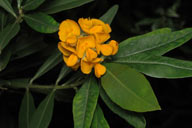In Flower This Week
A news sheet prepared by a Gardens' volunteer.
Numbers before each plant refer to temporary IFTW labels in the gardens.
Numbers in square brackets [ ] refer to garden bed Sections. Plants in flower are in bold type.
View past issues of 'In Flower This Week'.
25 November 2015
Callistachys lanceolata click for larger image |
Today we will visit the Asteraceae Garden to see the many daisies in flower.
- As you move into the Asteraceae Garden you will notice on your right Callistachys lanceolata [Section 5], a small tree with green leaves and orange pea flowers with red accents. Commonly known as the Wonnich or Native Willow, this plant is native to southwestern Western Australia.
- Also on your right as you enter the Asteraceae garden is Regelia inops [Section 5], an open bush with hard green foliage and spherical clusters of mauve flowers fading to pale pink. This plant is native to southwestern Western Australia
- The remainder of the plants listed are in Section 328 unless noted. Cassinia aureonitens on your right is a small bush with green linear foliage and large flat heads of bright lemon flowers. This plant is native to eastern New South Wales.
- On your left is Senecio pinnatifolius var. pinnatifolius, a small, open bush with divided blue-green foliage and golden flower heads. This plant is widely distributed around Australia.
- Also on your left is Brachyscome multifida ‘Breakoday’, a small daisy with fine green foliage and purple flower heads with golden centres. This plant is a seedling variation of Brachyscome multifida that arose in cultivation at Lilydale, Victoria in 1979.
- On your right is Xerochrysum bracteatum, a stiff paper daisy in various attractive colours with dark green leaves. This plant is widespread in various habitats in all Australian states and territories.
- On your right is Brachyscome segmentosa,with dainty green foliage and small mauve flower heads with golden centres. This plant is endemic to Lord Howe Island.
- Again on your right is Chrysocephalum apiculatum with grey-green foliage and bright golden “button” flower heads. This species is a perennial herb which is found in all states and territories in Australia in a wide range of environments. With such a broad distribution it is not surprising that this species varies considerably in form and foliage colour, from a sparse erect plant to much lower sprawling plants.
- On both the left and right is Rhodanthe chlorocephala subsp. rosea,a small daisywith white and pink flower heads. It is mostly found in southern Western Australia and adjacent South Australia.
- On your right is Xerochrysum viscosum, or Sticky Everlasting, a small bush with fine, tangled green foliage and yellow flower heads with golden centres. It is native to south-eastern Australia.
- To your left is Brachyscome iberidifolia, or Swan River Daisy, a small plant with ferny foliage and almost iridescent flower heads in varying shades of white, purple and mauve. It is native to the southern half of Western Australia.
- Also on your left is Brachyscome multifida ‘Amethyst’, a small daisy with fine green foliage and purple flower heads with golden centres. Many of the Brachyscome cultivars make excellent garden plants.
- Look to your right to see Kunzea pulchella, [Section 15r], a medium-sized bush with grey-green foliage and bright red pincushion flowers. It is endemic to the south-west of Western Australia, where it occurs on granite outcrops and slopes.
- On your left in a pot is Ozothamnus diosmifolius ‘Just Blush’, a small plant with very fine green foliage and large heads of white to pale pink flowers.
- On your left in a pot as you leave the Asteraceae Garden is Xerochrysum bracteatum ‘Lemon Monarch’,a paper daisy with large lemon-coloured flower heads with golden centres and soft green foliage.
Rosalind Walcott
![Director of National Parks [logo]](../../../../images/dnp_90px.gif)







